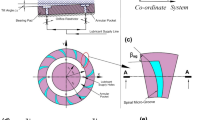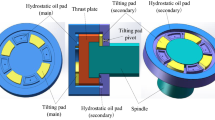Abstract
The present paper proposes a new type of hydrodynamic lubricated tilted pad thrust slider bearing which is augmented with the boundary slippage at the stationary contact surface in the inlet zone. This design is of purpose to reduce the friction coefficient but increase the load-carrying capacity of the bearing. A theoretical analysis is presented for this bearing. Computational results and design guides for this bearing are given. It is found that the most increase of the carried load of the bearing by the boundary slippage is around 30 %, while the most reduction of the friction coefficient of the bearing by the boundary slippage is more than 40 %. This advantage is reached when the boundary slippage zone occupies 80 % of the bearing lubricated area and the fluid-contact interfacial shear strength at the boundary slippage interface is very low.












Similar content being viewed by others
Abbreviations
- DU :
-
dimensionless interfacial slipping velocity, Δu a,x /u
- F f,a ,F f,b :
-
friction forces per unit contact length at the upper and lower contact surfaces in the bearing respectively
- \(\bar{F}_{f,a},\bar{F}_{f,b}\) :
-
dimensionless friction forces per unit contact length at the upper and lower contact surfaces respectively
- f a,conv ,f b,conv :
-
friction coefficients at the upper and lower contact surfaces in the bearing respectively calculated from conventional hydrodynamic lubrication theory
- f a,slip ,f b,slip :
-
friction coefficients at the upper and lower contact surfaces in the bearing respectively when the boundary slippage is introduced
- h :
-
fluid film thickness
- h 0 :
-
fluid film thickness at the outlet
- h i :
-
fluid film thickness at the inlet
- h 1 :
-
fluid film thickness at x=x 1
- H :
-
h/h 0
- H i :
-
h i /h o
- H 1 :
-
h 1/h o
- I w :
-
relative increase of the carried load of the present bearing compared with the conventional bearing (without boundary slippage)
- k :
-
tan(θ)
- l 1,l 2 :
-
widths of the no slippage zone and slippage zone of the bearing respectively, Fig. 1(a)
- l p :
-
distance of the pivot of the bearing from the outlet
- \(\bar{l}_{p}\) :
-
dimensionless distance of the pivot of the bearing from the outlet, l p /(l 1+l 2)
- p :
-
fluid film pressure
- p 1 :
-
fluid film pressure at x=x 1
- p conv :
-
pressure in the bearing calculated from conventional hydrodynamic lubrication theory
- P :
-
dimensionless pressure, ph 0/(uη a )
- q v :
-
fluid volume flow rate per unit contact length
- Q v :
-
dimensionless volume flow rate of the fluid through the bearing, q v /(uh 0)
- u :
-
moving speed of the lower contact surface of the bearing, Fig. 1(a)
- w conv :
-
carried load per unit contact length of the bearing calculated from conventional hydrodynamic lubrication theory
- w slip :
-
carried load per unit contact length of the bearing with boundary slippage
- W :
-
dimensionless load, w/(uη a )
- x :
-
coordinate
- x 1 :
-
x coordinate at the boundary between the “A” and “B” sub zones
- x 2 :
-
x coordinate at the inlet
- X :
-
dimensionless coordinate, x/[(l 1+l 2)cosθ]
- X 1 :
-
x 1/[(l 1+l 2)cosθ]
- τ sa :
-
fluid-contact interfacial shear strength at the stationary contact surface in the inlet zone
- \(\bar{\tau}_{sa}\) :
-
dimensionless fluid-contact interfacial shear strength at the stationary contact surface in the inlet zone, τ sa h 0/[uη a cos(2θ)]
- τ sa,B :
-
fluid-contact interfacial shear strength at the upper contact surface in the “B” sub zone
- \(\bar{\tau}_{sa,B}\) :
-
τ sa,B h 0/(uη a )
- θ :
-
tilted angle of the bearing
- τ a,A :
-
shear stress of the fluid film in the x coordinate direction at the upper contact surface in the “A” sub zone, Fig. 1(a)
- τ sb :
-
fluid-contact interfacial shear strength at the lower contact surface
- \(\bar{\tau}_{sb}\) :
-
τ sb h 0/(uη a )
- τ s0 :
-
uη a cos(2θ)/h 0
- α :
-
h 0/(l 1+l 2)
- η a :
-
fluid viscosity at ambient pressure
- τ :
-
shear stress
- \(\bar{\tau}\) :
-
dimensionless shear stress, τh 0/(uη a )
- Δu a,x :
-
fluid film slipping velocity at the upper contact surface in the “A” sub zone which is in the x coordinate direction
- a :
-
at the upper contact surface
- b :
-
at the lower contact surface
- A :
-
in the “A” sub zone
- B :
-
in the “B” sub zone
- slip:
-
for the boundary slippage case
- conv:
-
calculated from conventional hydrodynamic lubrication theory, which neglects the boundary slippage
References
Pinkus O, Sternlicht B (1961) Theory of hydrodynamic lubrication. McGraw-Hill, New York
Jacobson BO, Hamrock BJ (1984) Non-Newtonian fluid model incorporated into elastohydrodynamic lubrication of rectangular contacts. ASME J Tribol 106:275–284
Vinogradova OI (1995) Drainage of a thin liquid film confined between hydrophobic surfaces. Langmuir 11:2213–2220
Kaneta M, Nishikawa H, Kameishi K (1990) Observation of wall slip in elastohydrodynamic lubrication. ASME J Tribol 112:447–452
Guo F, Wong PL (2005) An anomalous elastohydrodynamic lubrication film: Inlet dimple. ASME J Tribol 127:425–434
Yagi K, Kyogoku K, Nakahara T (2005) Relationship between temperature distribution in EHL film and dimple formation. ASME J Tribol 127:658–665
Bonaccurso E, Butt HJ, Craig VSJ (2003) Surface roughness and hydrodynamic boundary slip of a Newtonian fluid in a completely wetting system. Phys Rev Lett 90:144501
Pit R, Hervet H, Leger L (2000) Direct experimental evidence of slip in hexadecane: solid interfaces. Phys Rev Lett 85:980–983
Zhang YB, Wen SZ (2002) An analysis of elastohydrodynamic lubrication with limiting shear stress: Part I—Theory and solutions. Tribol Trans 45:135–144
Spikes HA (2003) The half-wetted bearing. Part 1: Extended Reynolds equation. Proc Inst Mech Eng, Part J J Eng Tribol 217:1–14
Spikes HA (2003) The half-wetted bearing. Part 2: Potential application in low load contacts. Proc Inst Mech Eng, Part J J Eng Tribol 217:15–27
Salant RF, Fortier AE (2004) Numerical analysis of a slider bearing with a heterogeneous slip/no-slip surface. Tribol Trans 47:328–334
Fortier AE, Salant RF (2005) Numerical analysis of a journal bearing with a heterogeneous slip/no-slip surface. ASME J Tribol 127:820–825
Zhang YB (2008) Boundary slippage for generating hydrodynamic load-carrying capacity. Appl Math Mech 29:1155–1164
Zhang YB (2010) Boundary slippage for improving the load and friction performance of a step bearing. Trans Can Soc Mech Eng 34:373–387
Acknowledgements
The author would like to express thanks to the project from the Changzhou Science and Technology Bureau (CJ20120033), the Dean Project of the Natural Science Foundation of China (51145016) and the Qing Lan Project of Jiangsu Provincial Education Bureau.
Author information
Authors and Affiliations
Corresponding author
Rights and permissions
About this article
Cite this article
Zhang, Y. A tilted pad thrust slider bearing improved by the boundary slippage. Meccanica 48, 769–781 (2013). https://doi.org/10.1007/s11012-012-9630-6
Received:
Accepted:
Published:
Issue Date:
DOI: https://doi.org/10.1007/s11012-012-9630-6





